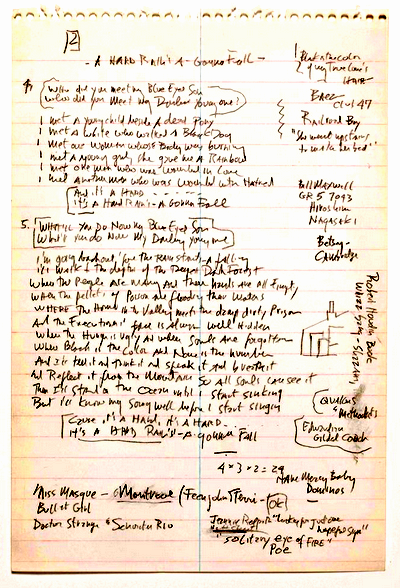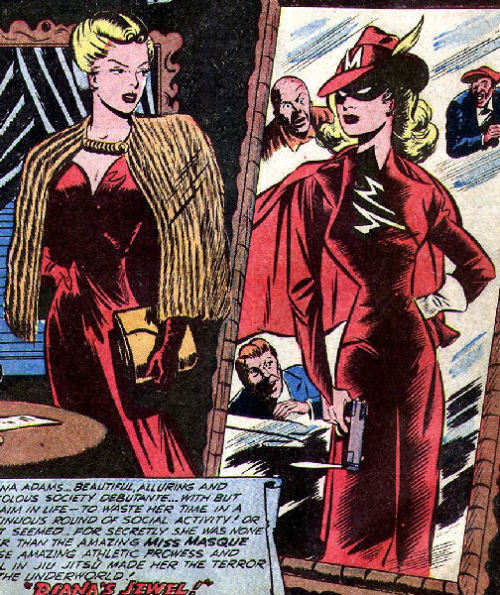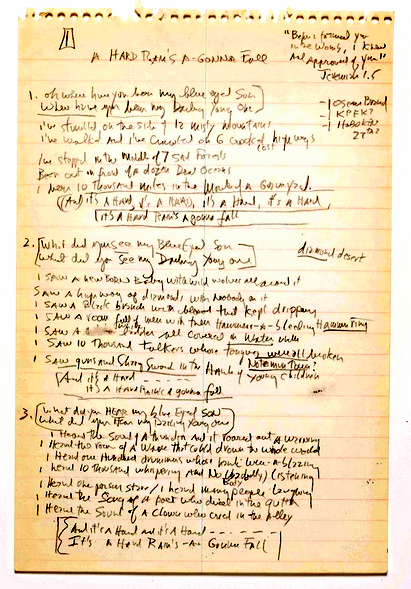
In 1963, when Studs Terkel spoke about “A Hard Rain’s A-Gonna Fall” during a radio interview with Bob Dylan, he made a comment to Dylan about how the song had come out of his feelings about “atomic rain.”
“No, no,” Dylan said. “It’s not atomic rain, it’s just a hard rain. It isn’t the fallout rain. I mean some sort of end that’s just gotta happen … In the last verse, when I say, ‘the pellets of poison are flooding the waters’, that means all the lies that people get told on their radios and in their newspapers.”
Now it turns out Dylan was telling stories, and not being frank with Terkel.
Two pages of the working manuscript for “A Hard Rain’s Gonna Fall” will be auctioned by Sotheby’s on June 24, 2014 in New York.
In examining photos of the manuscript pages that appeared in a New York Times story about the auction of this manuscript and the one for “Like A Rolling Stone,” it’s clear that Dylan meant the song to refer, at least in the chorus, to nuclear annihilation.
Right on the manuscript maybe two inches to the right of the line “It’s A Hard Rain’s A Gonna Fall” Dylan wrote “Hiroshima” and under that, “Nagasaki” — the two Japanese cities the U.S. bombed during World War II. A uranium gun-type atomic bomb (Little Boy) was dropped on Hiroshima on August 6, 1945, followed by a plutonium implosion-type bomb (Fat Man) on the city of Nagasaki on August 9. according to Wikipedia.
Clearly Dylan was being Dylan when he spoke to Terkel.
Unlike the manuscript for “Like A Rolling Stone,” where that song was a work in progress, “A Hard Rain’s A-Gonna Fall” is finished. But what’s interesting about these two manuscript pages are other things that Dylan has written on the pages.
For instance, near the right edge of the second page it says “Robert Houdin book,” which likely refers to a book about the French magician Jean Eugène Robert-Houdin, who is considered the father of modern conjuring.
On that same page Dylan wrote “Black is the color of my true love’s hair,” which is the title of an Appalachian folk song that Joan Baez recorded in 1962; on the manuscript, below the name of that song, Dylan has written “Baez Club 47.” Club 47 was a Cambridge, Massachusetts folk music venue where Dylan performed.
Joan Baez, “Black is the Color (Of My True Love’s Hair)”:
Also written at the side of the manuscript is “Railroad Boy,” which was the name Dylan and Baez used for a song that was variously called “The Butcher’s Boy,” “Go Bring Me Back My Blue-Eyed Boy” and “London City.” Dylan heard a 1928 recording of “The Butcher’s Boy” by Buell Kazee on Harry Smith’s Anthology of American Folk Music. Below “Railroad Boy” is a line from the song: “She went upstairs to make her bed.”
Bob Dylan, “Railroad Boy” (May 1961):
Buell Kazee, “The Butcher’s Boy”:
Bob Dylan and Joan Baez, “Railroad Boy” (1987):
Dylan wrote “Doctor Strange.” near the bottom of the page and “Miss Masque” and “Bullet Girl,” all names of comic book super heroes, although the third super hero was actually called “Bulletgirl.”

Dylan quoted from Edgar Allen Poe’s “The Black Cat,” writing down the phrase “solitary eye of fire.” The short story is about “a murderer [who] carefully conceals his crime and believes himself unassailable, but eventually breaks down and reveals himself, impelled by a nagging reminder of his guilt,” according to Wikipedia.
And he wrote “Have Mercy Baby,” and “Dominoes,” referring of course to The Dominoes’ “Have Mercy Baby,” an R&B hit in 1952.
The Dominoes,” Have Mercy Baby”:
Clearly even in 1962 when Dylan wrote “A Hard Rain’s A-Gonna Fall,” he was already a master collage artist, utilizing bits and pieces of culture from the past to craft his own unique art.
The two manuscript pages are expected to sell for between $400,000 and $600,000 according to the New York Times.
“A Hard Rain’s A-Gonna Fall” (Town Hall, New York, April 12, 1963):

– A Days of the Crazy-Wild blog post: sounds, visuals and/or news –-
It’s okay to tell stories… The lies come true eventually.
The fact that he mentions Hiroshima and Nagasaki in the margin does not prove the song is specifically about nuclear war. None the other stuff in the margins has any direct relevance to the song so why should that particular note?
two words ”lord randel”…….. get it